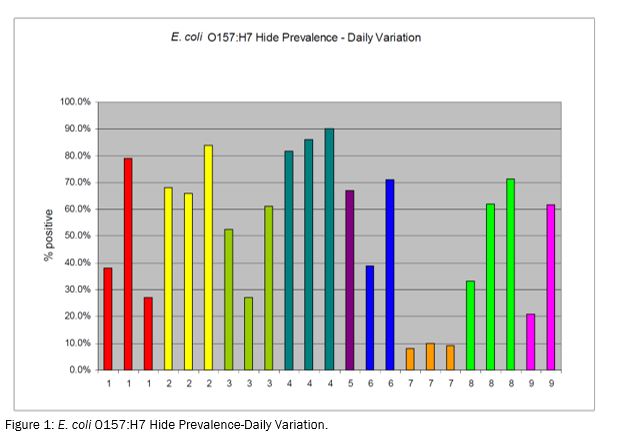Project Summary
Regional Variation in the Incidence of E. coli O157:H7 on the Hides and Carcasses of Feedlot-Finished Cattle
- Principle Investigator(s):
- Mohammad Koohmaraie
- Institution(s):
- USDA-ARS Meat Animal Research Center
- Completion Date:
- May 2004
Background
Outbreaks of food-borne illness linked to consumption of hamburger contaminated with E. coli
O157:H7 have had a devastating effect on profitability of the beef industry. Although it has been established that the prevalence of E. coli O157:H7 on the hides of fed cattle entering Midwestern
packing plants is high, little is known about the prevalence of E. coli O157:H7 across other
regions of the country. Circumstantial evidence from the incidence of meat recalls suggests that
the prevalence of E. coli O157:H7 is greater in some regions of the country than others. Thus,
the proposed experiment was designed to establish the prevalence of E. coli O157:H7 on the hides
and carcasses of feedlot-finished cattle in seven cattle feeding regions.
The objectives of this study were as follows:
- Determine if there are regional differences in the prevalence of E. coli O157:H7 on the hides and pre-evisceration carcasses of feedlot-finished cattle.
- Determine if there are unique E. coli O157:H7 pulsed-field gel electrophoresis patterns for isolates obtained from the hides of cattle originating from individual feedlots or geographical regions.
Methodology
Hide and pre-evisceration carcass samples were obtained from nine fed cattle slaughter plants
from the major cattle-producing regions of North America. 2,700 hide and 2,700 carcass
(n = 5,400) samples were collected from the nine fed-cattle slaughter plants. For each plant, 300
samples of each type were collected, with sampling occurring on three days with 100 hide and
100 carcass samples obtained on each day. Sampling with wetted sponges was done at two
locations on the processing line: (1) hide, sampled after hide opening before hide removal and
(2) pre-evisceration, immediately following dehiding before any antimicrobial applications.
Samples were analyzed for Enterobacteriaceae counts, aerobic plate counts, and prevalence of
E. coli O157:H7.
Findings
2,591 samples of both hides and pre-evisceration carcasses were analyzed. It was not believed that these differences are due to regional effects. The
reason for this belief comes, in part, from the day-to-day variation observed in sampling. With
the exception of one plant, large fluctuations of E. coli O157:H7 prevalence in hide samples occurred from one day to the next. Every plant except one had at least one sampling day where the hide prevalence of E. coli O157:H7 was over 60%. The one plant being the exception was sampled in a previous study and found to have hide prevalence for E. coli O157:H7 of more than 80% (See Figure 1). Transfer rates of E. coli O157:H7 from hide to the carcass surface varied widely. The preevisceration carcass prevalence for E. coli O157:H7 ranged from 8% to 51% but did not mirror the hide prevalence fluctuations (See Table 1). The transference of pathogens from hide to carcass surface varied by plant, likely due to the carcass dressing practices employed at the
individual plants.
Implications
The results of this study suggested that there are day-to-day differences but not regional variation in the prevalence of E. coli O157:H7 on the hides and pre-evisceration carcasses of feedlot finished cattle.
Table 1: E. coli O157:H7 % Prevalence by Plant.
|
Plant |
1 |
2 |
3 |
4 |
5 |
6 |
7 |
8 |
9 |
Total |
|
Hide |
48.0 |
72.7 |
46.3 |
85.3 |
67.0 |
47.6 |
9.0 |
53.0 |
45.3 |
52.9 |
|
Pre-evis |
51.0 |
9.0 |
34.3 |
38.7 |
25.7 |
55.5 |
8.0 |
33.0 |
23.7 |
29.9 |
